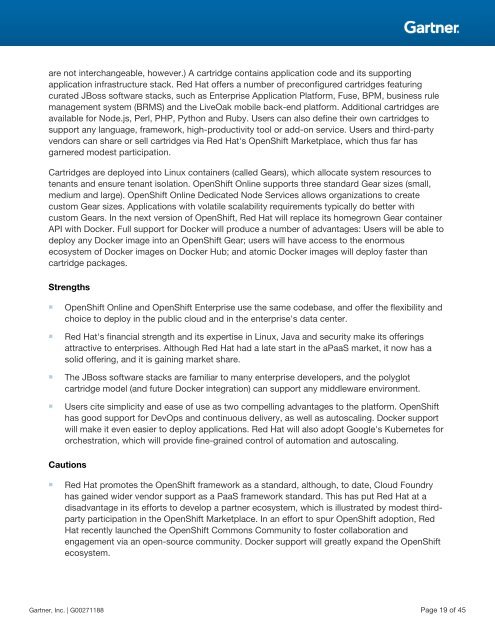Magic Quadrant for Enterprise Application Platform as a Service, Worldwide
Create successful ePaper yourself
Turn your PDF publications into a flip-book with our unique Google optimized e-Paper software.
are not interchangeable, however.) A cartridge contains application code and its supporting<br />
application infr<strong>as</strong>tructure stack. Red Hat offers a number of preconfigured cartridges featuring<br />
curated JBoss software stacks, such <strong>as</strong> <strong>Enterprise</strong> <strong>Application</strong> Plat<strong>for</strong>m, Fuse, BPM, business rule<br />
management system (BRMS) and the LiveOak mobile back-end plat<strong>for</strong>m. Additional cartridges are<br />
available <strong>for</strong> Node.js, Perl, PHP, Python and Ruby. Users can also define their own cartridges to<br />
support any language, framework, high-productivity tool or add-on service. Users and third-party<br />
vendors can share or sell cartridges via Red Hat's OpenShift Marketplace, which thus far h<strong>as</strong><br />
garnered modest participation.<br />
Cartridges are deployed into Linux containers (called Gears), which allocate system resources to<br />
tenants and ensure tenant isolation. OpenShift Online supports three standard Gear sizes (small,<br />
medium and large). OpenShift Online Dedicated Node <strong>Service</strong>s allows organizations to create<br />
custom Gear sizes. <strong>Application</strong>s with volatile scalability requirements typically do better with<br />
custom Gears. In the next version of OpenShift, Red Hat will replace its homegrown Gear container<br />
API with Docker. Full support <strong>for</strong> Docker will produce a number of advantages: Users will be able to<br />
deploy any Docker image into an OpenShift Gear; users will have access to the enormous<br />
ecosystem of Docker images on Docker Hub; and atomic Docker images will deploy f<strong>as</strong>ter than<br />
cartridge packages.<br />
Strengths<br />
■<br />
■<br />
■<br />
■<br />
OpenShift Online and OpenShift <strong>Enterprise</strong> use the same codeb<strong>as</strong>e, and offer the flexibility and<br />
choice to deploy in the public cloud and in the enterprise's data center.<br />
Red Hat's financial strength and its expertise in Linux, Java and security make its offerings<br />
attractive to enterprises. Although Red Hat had a late start in the aPaaS market, it now h<strong>as</strong> a<br />
solid offering, and it is gaining market share.<br />
The JBoss software stacks are familiar to many enterprise developers, and the polyglot<br />
cartridge model (and future Docker integration) can support any middleware environment.<br />
Users cite simplicity and e<strong>as</strong>e of use <strong>as</strong> two compelling advantages to the plat<strong>for</strong>m. OpenShift<br />
h<strong>as</strong> good support <strong>for</strong> DevOps and continuous delivery, <strong>as</strong> well <strong>as</strong> autoscaling. Docker support<br />
will make it even e<strong>as</strong>ier to deploy applications. Red Hat will also adopt Google's Kubernetes <strong>for</strong><br />
orchestration, which will provide fine-grained control of automation and autoscaling.<br />
Cautions<br />
■<br />
Red Hat promotes the OpenShift framework <strong>as</strong> a standard, although, to date, Cloud Foundry<br />
h<strong>as</strong> gained wider vendor support <strong>as</strong> a PaaS framework standard. This h<strong>as</strong> put Red Hat at a<br />
disadvantage in its ef<strong>for</strong>ts to develop a partner ecosystem, which is illustrated by modest thirdparty<br />
participation in the OpenShift Marketplace. In an ef<strong>for</strong>t to spur OpenShift adoption, Red<br />
Hat recently launched the OpenShift Commons Community to foster collaboration and<br />
engagement via an open-source community. Docker support will greatly expand the OpenShift<br />
ecosystem.<br />
Gartner, Inc. | G00271188 Page 19 of 45



